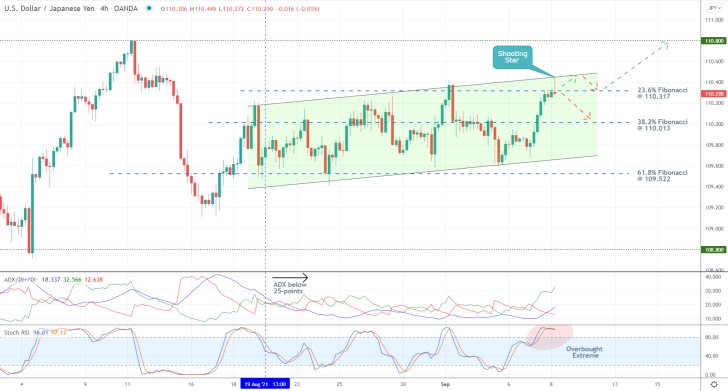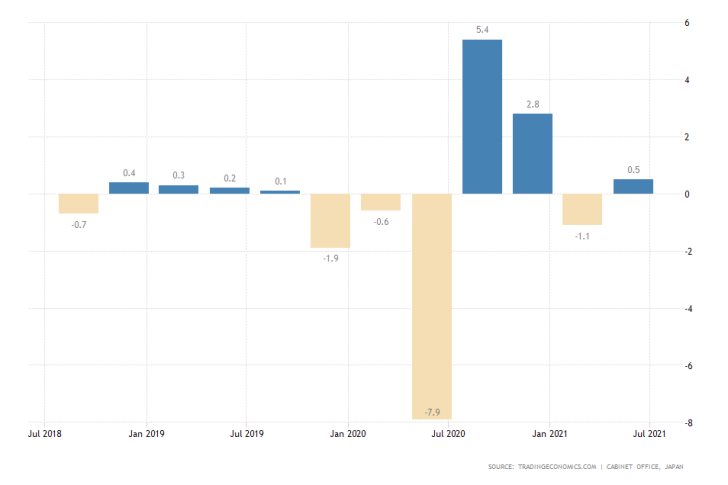
The yen's temporary strengthening is in stark contrast to the broader bearish sentiment of the currency. This is the type of divergence between short term and long term pressures that tends to create interesting trading opportunities. Check out our latest GBPJPY analysis for additional information.
Japan's GDP growth in the second quarter surpassed the market forecasts, as was reported by the Cabinet Office in the early hours of the Asian session. The stronger-than-expected economic expansion was driven by a solid pick-up in economic activity and global demand.
Similar observations regarding activity in the East Asia/ South Pacific region were drawn by the RBA yesterday. Japan's solid quarterly performance thus bolstered the yen in the short term and seemingly primed the USDJPY for a new downswing.

As shown on the 4H chart above, the price action is currently probing the upper boundary of the range and the 61.8 per cent Fibonacci retracement level at 110.317. The crossover of the two represents a significant resistance level and a prominent turning point.
Nevertheless, if the price manages to consolidate above the two, it would then likely target the previous swing peak at 110.800. The currently evolving Shooting Star candle, however, seems to corroborate the opposite expectations for an upcoming reversal.
This is further bolstered by the fact that the ADX indicator has been threading below the 25-point benchmark since the 19th of August, which confirms the ostensibly range-trading environment. Under these conditions, sharp turns in the direction of the price action from major levels of support and resistance are made even likelier.
Notice also that the Stochastic RSI indicator has been threading in its overbought extreme for a while, which could catalyse an upsurge in selling pressure in the near future.
Better-than-expected GDP growth numbers
Japan's economy grew by 0.5 per cent in the second quarter, beating preliminary estimations of a 0.3 per cent expansion. The initial forecasts were projecting no likely changes between the preliminary and final readings.

As mentioned above, the upward revision is owing mostly to a strong uptick in demand over the same period.
Trendsharks Premium
Gold is undergoing a correction, as investors take profits to offset losses from falling stock prices, impacting their margins. However, we anticipate a renewed wave of [...]
The Swiss stock market index is mirroring its global counterparts, such as Germany 40 and US100, experiencing a sharp decline following the announcement of new [...]
We’re analyzing the weekly chart to grasp the broader market trend. Over the past three years, the US30 index has surged by 17,000 points, often resembling a nearly straight [...]
Over the past week, the DAX has experienced a sharp decline, plunging by an astonishing 3,400 points. This downward movement is not isolated, as its international counterparts, such as the UK100 and US100, are also facing significant [...]
EURUSD recently formed a double top at 1.0930, signaling a potential trend reversal, and has since begun a correction. After a 600-pip rally since early March, a pullback at this stage is both expected and healthy. Given these conditions, we are placing a [...]
Since early March, EURJPY has surged nearly 1,000 pips, providing us with several excellent trading opportunities. However, as the rally matures, many early buyers are beginning to take profits, leading to a noticeable slowdown in the uptrend. On Friday, the pair formed a [...]
The AUDJPY currency pair continues to be dominated by bullish momentum, as multiple golden cross patterns reaffirm the strength of the ongoing uptrend. Despite this, we are witnessing a much-needed [...]
The EURAUD currency pair appears to be undergoing a trend reversal, signaling a potential shift in market direction. A notable technical development is the formation of a Death Cross on the chart, a widely recognized bearish indicator that typically suggests a [...]
After securing an impressive 200-pip profit last week, the EURJPY currency pair is now undergoing a southward correction, retracing some of its recent gains. Despite this temporary pullback, the Golden Cross remains intact, reinforcing our view that the overall trend continues to be [...]
The appearance of a Golden Cross in Silver strengthens our analysis that the metal is currently in a strong uptrend, indicating further bullish momentum in the market. This technical pattern, where the short-term moving average crosses above the [...]
This trade presents a considerable level of risk and can be classified as an opportunistic move based on recent price action. The GBPUSD currency pair has experienced a substantial bullish rally, surging by nearly 500 pips in a strong upward movement. However, after this extended period of appreciation, the pair is showing signs of a potential [...]
The anticipated Death Cross on the SMI20 appears to be failing as price finds strong support at the 23% Fibonacci retracement level. After testing this area, the index has shown bullish strength, printing several large green candles, signaling an increase in [...]
A Golden Cross has just appeared on the USDJPY chart, signaling a potential bullish move. This technical pattern occurs when the 20 period moving average crosses above the 60 period moving average, a widely recognized indication of increasing [...]
After 2 months of a down trend, we finally see some indications of price recovery for Oil. The golden cross, a historic buy signal, supports this [...]
For the past month, the German DAX40 has experienced a remarkable 10% surge, reflecting strong bullish momentum. Despite ongoing market volatility and frequent pullbacks, every dip continues to attract fresh buyers, reinforcing the [...]
Oil continues its downward trajectory, despite occasional pullbacks. The overall trend remains bearish, reinforced by multiple Death Cross patterns, a classic sell signal indicating further weakness. Adding to this bearish outlook, the critical [...]
Over the past few days, gold has experienced a sharp decline of more than $100. This downturn can be attributed in part to traders securing profits to manage their margins, which are under strain due to the significant drop in major indices. Currently, gold has fallen below the [...]
The NASDAQ 100 index is showing strong bullish momentum, as evidenced by the formation of a Golden Cross on the chart. This classic buy signal occurs when the short moving average crosses above the long term moving average, suggesting that upward momentum is [...]
The EURAUD currency pair has encountered a significant resistance level, failing to break above the critical 61% Fibonacci retracement level. This suggests that bullish momentum is weakening, reinforcing the case for a potential downward move. Given this technical setup, we favor entering a [...]
The UK100 is experiencing a remarkable rally! Over the past few weeks, the British stock market index has surged nearly 800 points. Each minor dip has attracted more buyers, fueling the bullish momentum. However, since last week, we’ve observed a slight [...]




















